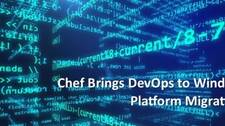Chef Brings DevOps to Windows Platform Migrations

Limited Time Offer!
For Less Than the Cost of a Starbucks Coffee, Access All DevOpsSchool Videos on YouTube Unlimitedly.
Master DevOps, SRE, DevSecOps Skills!
Source:-devops.com
Chef and Microsoft revealed today that they are working together to apply DevOps processes to accelerate the migration of Windows Server 2008 and SQL Server 2008 to more current versions.
Announced at the Microsoft Inspire conference, the goal is to enable organizations to leverage Chef Enterprise Automation Stack (EAS), which includes an EAS Migration Accelerator for Windows that will scan existing .NET applications running on legacy Microsoft platforms to discover configuration and dependency details, then encapsulate that information as code in a way that enables the application to run on the latest version of a Microsoft virtual machine or as a container.
Ewan Dalton, partner development manager for Microsoft, said there are roughly a half-million .NET applications running on platforms that are scheduled for end-of-life support beginning in January. In an ideal world, most of those applications would be modernized to be deployed on the Microsoft Azure cloud, said Dalton.
Vikram Ghosh, vice president of business development at Chef, said rather than merely lifting and shifting legacy applications onto a new platform, Chef EAS will make it possible to employ DevOps processes to modernize how those applications are updated and maintained. Chef EAS makes it possible to, for example, scan, extract and package legacy applications and their dependencies, using source control repositories such as GitHub, and convert them into cloud platforms using pipelines such as Azure DevOps. Customers can deploy these application packages in Azure and run continuous security and compliance scans, added Ghosh.
Chef EAS
The biggest challenge many organizations face when trying to migrate applications is the developers who created the application haves long since left the company. As such, most organizations only have documentation, which is usually sparse. They then must determine whether it is worth modernizing the application or whether they should simply replace it. In cases where it is deemed that the business logic contained within that legacy application is still critical enough to continue running, they need to find a way to automate that process as much as possible.
Longer-term, of course, most organizations will work to modernize legacy monolithic applications even further by slicing them up into a series of more manageable microservices. But many organizations are already running out of time when it comes to existing .NET applications. Once Microsoft ends support for the platforms they are running on, patches to address cybersecurity issues no longer will be provided as part of the standard licensing agreement. In effect, that means there is enough time between now and January to re-engineer an application. Chef EAS essentially throws organizations a lifeline to determine what they want to do next in terms of replacing a legacy application, said Ghosh.
Of course, there will always be some subset of the IT community that will continue to run .NET applications on outdated Microsoft platforms. It’s also unlikely that any of those organizations will be embracing DevOps processes to maintain those platforms anytime soon.